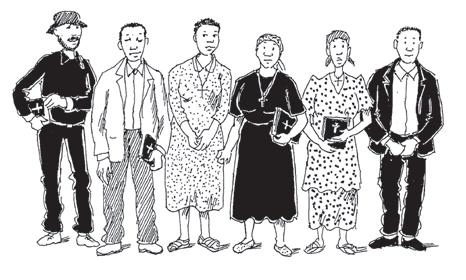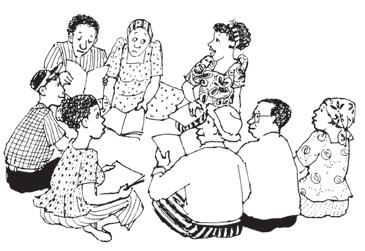
4 minute read
Introduction to gender and sexual violence
from Hands in Hand
The terms ‘sex’ and ‘gender’ are used to speak about the differences between men and women. ‘Sex’ relates to the biological differences between men and women – what makes us male and female. ‘Gender’ relates to the nonbiological differences between men and women, such as behaviour, dress, roles and responsibilities. It refers to the way society defines men and women, including their qualities and roles in a community: for example, a culture and society may say that women should be compassionate, gentle and nurturing, while men should be forceful and strong and take leadership. But is this always true for all men and women in all cultures? It is important to understand that since gender is a construct of society, it is not static: it is dynamic and changes with time and circumstances.
Unequal power relations
Advertisement
It is important to note that there are some apparently conflicting messages in the Bible about the roles of men and women (for example, Galatians 3:28 and 1 Timothy 2:11–12). We need to think carefully about the context and background of such passages to help us understand them. Christians still debate the ways in which we should apply these verses, and it is important to discuss our different views in a loving manner.
Unfortunately, relationships between men and women are not equal, because most societies give men more power over women. These influences shape the way women and men relate to one another in society. Individuals in positions of power can abuse their power, leading to psychological, emotional and physical violence: for example, a teacher insisting that a student has sex with them in exchange for good grades is an abuse of that teacher’s power over the student.
Since people create gender roles, people can also change them.
What is sexual violence?
Sexual violence is a form of gender-based violence. Sexual violence is one of the most destructive and yet leastrecognised human rights abuses in the world. As many as one in three women has been beaten, coerced into sex or abused in some other way – most often by someone she knows, including by her husband or another male family member. It is important to know that sexual violence is more often experienced by women and children; however, men can also experience sexual violence.
Sexual violence refers to any act, attempt or threat of a sexual nature that results in, or is likely to result in, physical, psychological and emotional harm.
‘Sexual violence refers to any unwanted sexual act or activity. There are many different kinds of sexual violence, including but not restricted to: rape, sexual assault, child sexual abuse, sexual harassment, rape within marriage / relationships, forced marriage, so-called honour-based violence, female genital mutilation, trafficking, sexual exploitation, and ritual abuse. Sexual violence can be perpetrated by a complete stranger, or by someone known and even trusted, such as a friend, colleague, family member, partner or ex-partner.’
Rape Crisis England and Wales (www.rapecrisis.org.uk)
Sexual violence happens when one person (the perpetrator) abuses the power that they have over another person (the survivor or victim), in a sexual way. In most cases, this takes place in a private or isolated location where there are no witnesses.
EXAMPLES
Anyone can become a target of sexual violence. It can take place in many different settings:
Inter-personal violence: sexual violence can happen within a marriage or relationship. These acts are often hidden because they happen within the home, away from public view. This can be a difficult cycle to break, even if the survivor wants the violence to stop.
Harmful traditional practices: some cultural rites of passage or practices can be harmful. Culture is very important but, if a practice is harmful, it is important to observe closely and try and suggest alternative practices. An example of this in some societies is female genital mutilation/ cutting (FGM/C).
Stranger violence: violence carried out by someone who is not known to the survivor.
EFFECTS
The effects of sexual violence can be both visible and invisible, affecting people from all parts of the community. Evidence of an attack can be found in blood stains, semen or any physical injuries from the attack. The survivor can also experience physical, mental and emotional wounds. Sexual violence can happen anywhere within the community, and to anyone. Sexual violence leaves its victims with long-term psychological and physical trauma, results in damaged relationships within families and communities, and is found within communities in all contexts, including those experiencing conflict.
How the church can help
In most communities, there are very limited resources available to support survivors after an act of sexual violence has occurred. In most countries, sexual violence is a criminal offence but very often the crimes are not reported to the police, especially if there are no witnesses to the attack as the survivor may feel that no one will believe them if they report the matter.
It is important for the church and community to understand more about sexual violence and what can cause attacks to happen. The survivor is NEVER to blame for the attack. Survivors require care and support as they seek to recover from the trauma. It is vital that survivors are supported and feel able to report the attack to the police and local authorities. It is equally important for the church to be equipped to support the emotional and physical needs of the survivors: for example, helping them seek medical help, comforting them, supporting them in denouncing perpetrators to the police and local authorities.
By discussing sexual violence openly through these Bible studies, individuals will understand that sexual violence is not acceptable and see that it is possible to prevent attacks from happening.







